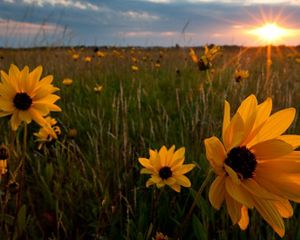Live From the Lek: The Nature Conservancy, DNR Stream Greater Prairie Chickens Booming at Bluestem Prairie
Media Contacts
-
Chris Anderson
Marketing Director
The Nature Conservancy, Minnesota
Phone: 612-845-2744
Email: canderson@tnc.org
The Minnesota Department of Natural Resources has placed a livestreaming camera at The Nature Conservancy’s Bluestem Prairie Preserve in Clay County, Minnesota to showcase the sights and sounds of greater prairie chickens annual mating behavior, known as booming.
At dawn, male prairie chickens venture out to a short-grass patch in the prairie known as a lek, where they perform an intricate courtship display where they hop, strut, flap their wings, fill their vibrant orange air sacs and make a low booming sound. That’s why the behavior is known as booming. The displaying birds may even spar with other males, all for the attention of females.
“All this fighting, displays and booming are the male prairie chicken’s way of showcasing his fitness to the females,” said Rob Baden, Minnesota DNR Area Wildlife Manager. “If you haven’t witnessed the dance of the prairie chicken you are missing one of nature’s finest shows.”
Prairie chicken hens look on to the booming males to scout out a mate. A hen signals to a male that she’s interested by dropping her wings and squatting. They mate on the lek, and then the hen finds taller grass to set up her nest and lay her dozen or so eggs.
Prairie chickens were once abundant across the Great Plains. Today, there are only about 360,000 living in small pockets of grassland like TNC’s Bluestem Prairie, which is one of the largest and highest quality remaining northern tallgrass prairies.
Habitat loss is the main culprit for the greater prairie chicken’s decline. The birds rely on large, nearly treeless landscapes of grassland. Most of their original range has been converted to agriculture over the last several decades, reducing their suitable habitat to a small fraction of what it once was.
“Greater prairie chickens are truly an icon of the prairie. I’m so excited to share this livestream so viewers can appreciate the beauty and spectacle of Minnesota’s grasslands,” said Ann Mulholland, director of The Nature Conservancy’s Minnesota, North Dakota and South Dakota chapter. “Watching the booming each spring reminds me how important our work to preserve and restore native grasslands for the survival not only of greater prairie chickens, but for all species that call the prairie home.
The Nature Conservancy, Minnesota DNR and United States Fish and Wildlife Service all have viewing blinds available for the public to reserve. Information on how to reserve a blind can be found here.
The Nature Conservancy is a global conservation organization dedicated to conserving the lands and waters on which all life depends. Guided by science, we create innovative, on-the-ground solutions to our world’s toughest challenges so that nature and people can thrive together. We are tackling climate change, conserving lands, waters and oceans at an unprecedented scale, providing food and water sustainably and helping make cities more resilient. The Nature Conservancy is working to make a lasting difference around the world in 81 countries and territories (40 by direct conservation impact and 41 through partners) through a collaborative approach that engages local communities, governments, the private sector, and other partners. To learn more, visit nature.org or follow @nature_press on X.


